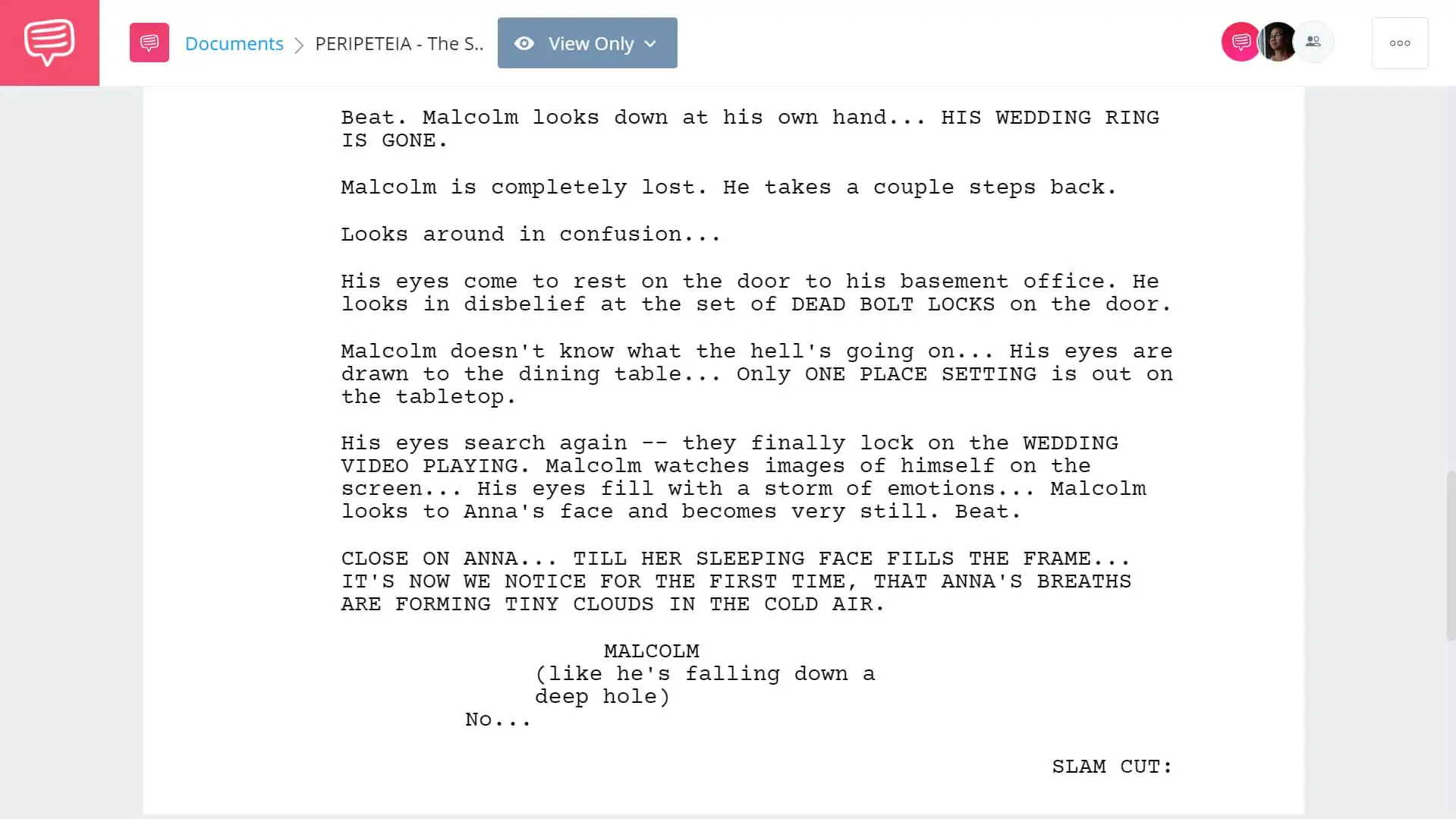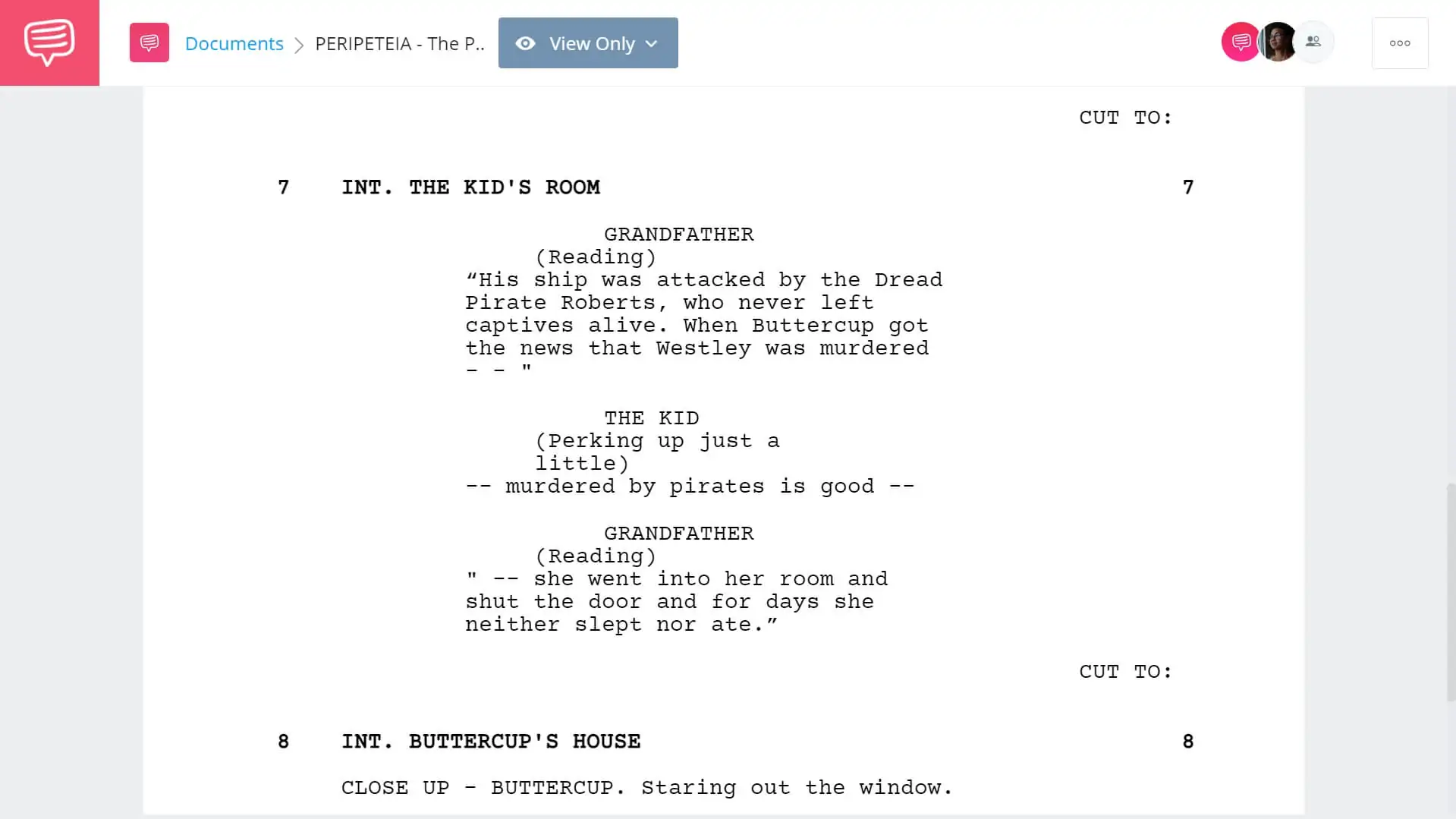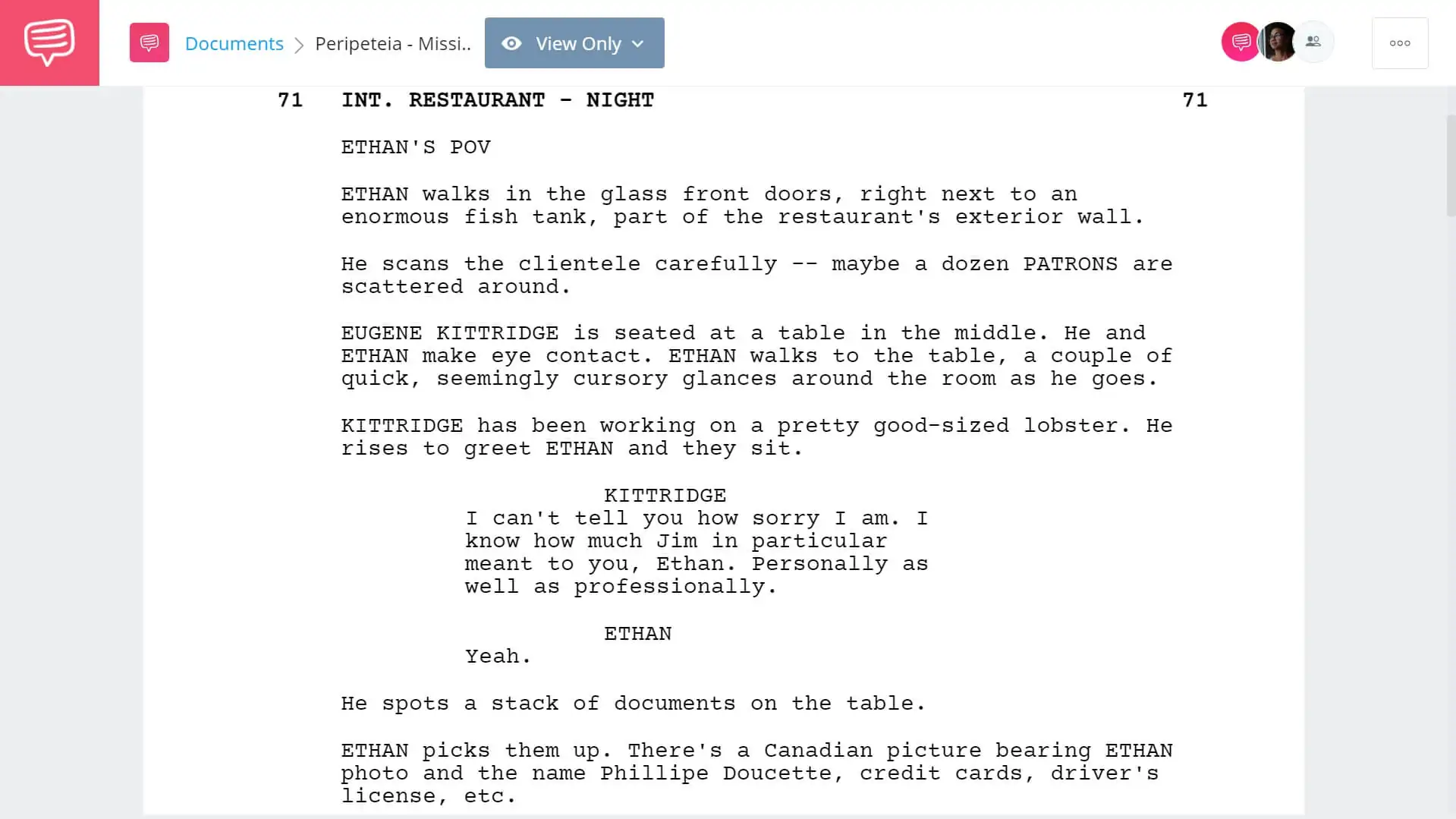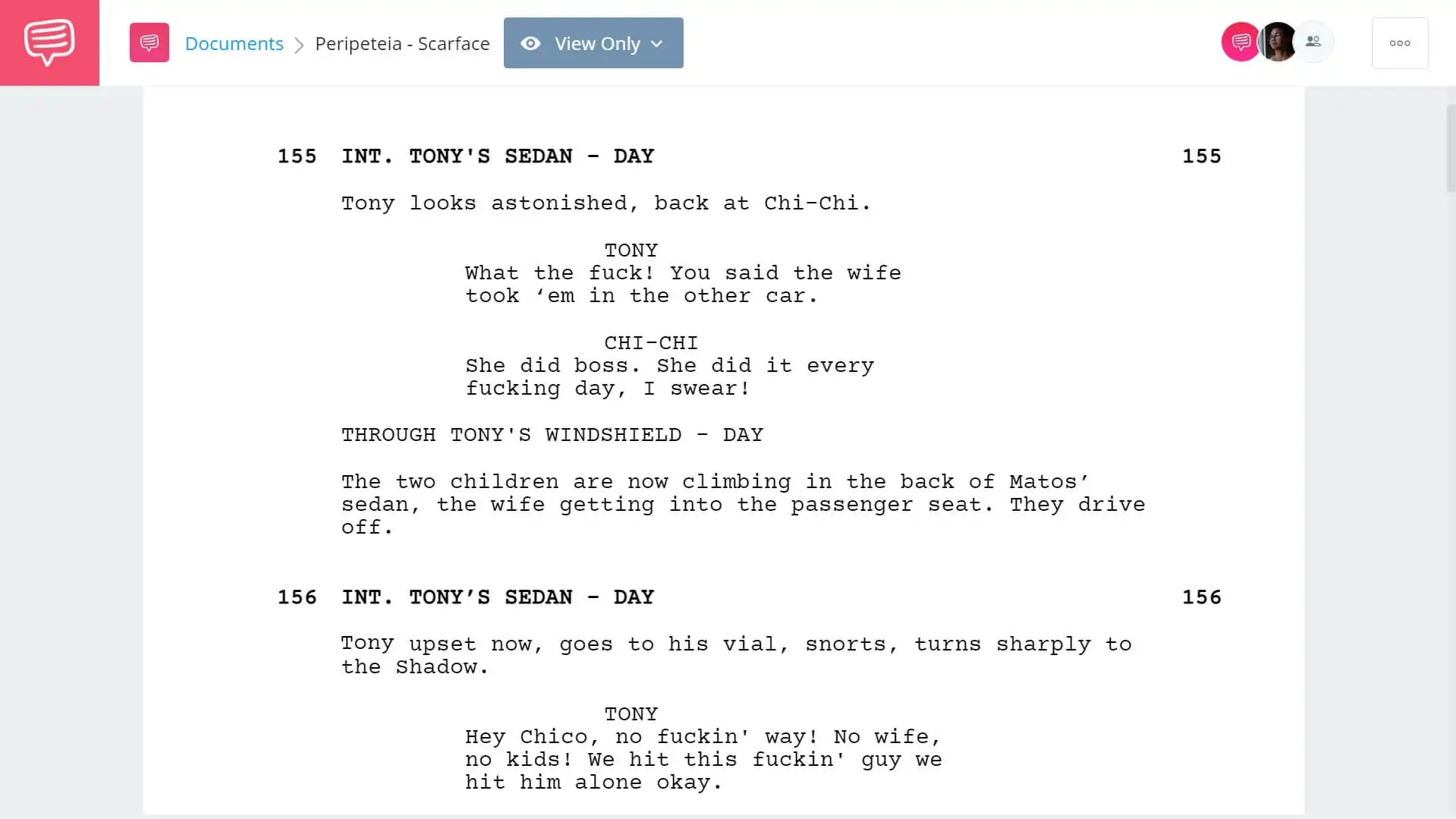Peripeteia. Is it a synonym for ‘onomatopoeia’? A fancy potato? A lyric from Mary Poppin’s “Supercalifragilisticexpialidocious? Excellent guesses, but no. Peripeteia isn’t written sound effects, a special tuber or delightful nonsense from the Poppinverse. So, what is peripeteia? Despite how intimidating it may appear on paper, the peripeteia definition is a simple, but crucial, story element that we will spell out for you. Hopefully, by the end of this article, you will be able to not only spell peripeteia but use it, too.
Peripeteia Definition
First, let’s define Peripeteia
The word, peripeteia means “reversal” in Greek and is a rhetorical literary device first coined by Aristotle, the preeminent Greek philosopher considered by many to be the father of modern story structure.
In his Poetics, Aristotle defines a slew of other rhetorical literary devices such as hubris, anagnorisis, dramatic irony, catharsis, and the rhetorical triangle. In his seminal work, he defines peripeteia as “a change by which the action veers round to its opposite, subject always to our rule of probability or necessity.” Great, but still wondering, "What is peripeteia?"
Let’s break it down in layman's terms.
PERIPETEIA DEFINITION
What is peripeteia?
Peripeteia is the moment a story halts going in one direction and takes off in the opposite one. It’s a turning point that makes the audience gasp and think “WHAAA? Didn’t see that one coming.” The dramatic shift can introduce the character to the action, add complications in their journey, or march them straight into the story’s climax and finale with raised stakes and anticipation.
The peripeteia definition in Greek tragedy has been expounded upon by filmmakers to include many interpretations and uses. We will examine some key examples of peripeteia in film and how you can use this device in your stories to subvert expectations and wring the maximum amount of entertainment from your screenplay.
Aristotle’s Other Poetics Devices
- Hamartia: Tragic Flaw
- Catharsis: The audience’s empathy with the character’s tragic flaw will rid them of their flaws in real life.
- Hubris: Pride that usually presages tragedy
- Reparation: The consequences a character suffers following peripeteia
Purpose of Peripeteia
How to make the most of peripeteia
So, what is peripeteia for? Though there are no hard and fast rules that tell us when and where to use peripeteia, Aristotle maintained it was most effective leading up to the climax in tragedies. He used the contemporaneous play Oedipus as his model. The peripeteia definition in Greek tragedy plays out when Oedipus realizes that he killed his father and married his mother, fulfilling the heinous prophecy he tried so hard to derail.
A Deep Dive into Aristotle’s Poetics
Many films follow this structure and spring a dramatic change onto their characters in the third act of their stories, including Casablanca, Usual Suspects, Cinderella, Star Wars Episode V: The Empire Strikes Back, Godfather: Part II and Vertigo.
Some, however, utilize it at the beginning or middle of their stories. And it is by no means delimited to tragedies. Screenwriters can use peripeteia in any genre to heighten the emotions of their audience, hook the main characters into the story, reveal a character’s true nature, and maintain momentum in long, complicated narratives.
Peripeteia Meaning in Film
Peripeteia provokes strong reactions
Genres which rely on the surprise and excitement of a twist, such as horror, tragedy, and thrillers often incorporate peripeteia into their plotlines to elicit strong emotions from the audience and keep them glued to the screen to see how it all ends. The best plot twist movies know how this is done.
The following section of peripeteia examples includes major spoilers for Psycho, Sunset Blvd., The Sixth Sense, The Princess Bride, Mission: Impossible, Get Out, Lawrence of Arabia, Scarface, Clue, and Arrival.
In one of the best horror films of all time, Psycho, Hitchcock used peripeteia to create the iconic moment of terror and shock that has gone down in cinematic history. The character, Marion, resolved to do the right thing after hearing Norman Bates’s sob story and return her stolen money, takes a shower before bed in the eerie Bates motel. Her fortunes abruptly take a turn for the worse, however, when the relaxing ritual is interrupted by a psycho with a knife.
Peripeteia in Psycho
In Psycho, the moment of peripeteia occurs right at the moment of Marion’s death, when the realization and horror dawns on her petrified face. The suddenness of this change scares the audience almost as much as it scares her and makes peripeteia an effective strategy to induce horror and escalate tension.
Peripeteia can also masterfully evoke feelings of pathos, pity and sadness. In the film noir tragedy, Sunset Boulevard, aging silent film actress, Norma Desmond, has passed her starlet expiry date. She spends her life reminiscing on her Hollywood glory days holed up in a mansion as she and her possessions atrophy in decay. She is granted a chance to star in a movie and she throws her existence into her comeback, preening and grooming, rekindled with purpose; but, in a reversal of fortune, she finds out the studio isn’t going to do her movie, and never intended to.
This beautiful depiction of peripeteia leaves the viewers overwhelmed with pity as Norma who can’t bear the news, shoots her lover, and descends into madness. “Life which can be strangely merciful had taken pity on Norma Desmond. The dream she had clung to so desperately had unfolded her.”
Norma Unravels in Sunset Boulevard
Dr. Malcolm Crowe in one of M. Night Shyamalan’s best movies, The Sixth Sense is the victim of peripeteia when, in the last scene of the film, he realizes that he is one of the dead people who’s been ‘haunting’ the little boy, Cole, whom he’s been trying to cure. His circumstances drastically change when he realizes he no longer has breath in his body and hasn’t for a years’ time. He’s been in a one-sided relationship with his wife, not because their marriage had deteriorated but because he had died.
It leaves him devastated and allows the audience to be moved by eeriness and pity. It also propels him to stop unwittingly haunting his wife and leave her in peace. We imported the screenplay for The Sixth Sense into StudioBinder’s screenwriting software to isolate the moment peripeteia unfolds.
What is Peripeteia in The Sixth Sense • Read the Entire Scene
All three of these examples highlight the importance of peripeteia in drawing emotional responses from the audience.
Peripeteia Properties
Peripeteia propels the story forward
Peripeteia packs a punch at the climax of a film, but it can also work effectively near the beginning or middle to push characters into the action and pull viewers into the story.
In the fantasy-adventure-parody, Princess Bride, Buttercup is thrust into the story because of peripeteia. When the love of her life, Westley is allegedly kidnapped and killed by the Dread Pirate Roberts, Buttercup loses all momentum for living and grants the evil doofus, Prince Humperdinck her hand in marriage.
This drastic reversal of fortune is what spurs her to make a careless decision, sacrificing her heart and well-being to someone untrustworthy. In the screenplay for Princess Bride, peripeteia leads Prince Humperdinck to choose her, stage her kidnapping and set off the entire adventure that reunites her with Westley, who is very much alive.
Peripeteia as Inciting Incident in Princess Bride • Read the Entire Scene
Peripeteia can also prod a reluctant hero to pursue her/his goal. In Mission: Impossible, Ethan Hunt is overwhelmed by depression when his spy team is murdered in a botched mission. But peripeteia forces him to put a pin in his grief and chase after his goal.
He finds out from the agency’s leader, that his team’s mission was really set up all along by his spy agency to root out a mole. This circumstance, displayed in the scene forces him to go rogue, find the real mole and exonerate himself.
Peripeteia in Mission Impossible • Read the Entire Scene
Peripeteia can manifest in a film’s mise-en-scene as well. In this scene, director Brian de Palma uses dutch angles to heighten Ethan’s crushing feeling upon hearing the news that he was played like a pawn. To signal this story and tonal shift, the visual language also takes on a drastic shift.
How to Use the Dutch Angle • Subscribe on YouTube
Any peripety in your script poses an ideal moment to insert the disorienting and unsettling dutch angle, as the turning point usually occurs at a dramatic juncture in your story.
Peripeteia Examples
Peripeteia plays with perception
If you’re still wondering what is peripeteia’s purpose, stop looking at the screen and survey the audience. Peripeteia can subvert an audience’s perception of a character or story. It can also deepen their empathy and understanding for a character and amplify the shock of their betrayals.
Writer and director Jordan Peele in his acclaimed 2018 sci-fi horror romp,
Get Out, uses peripeteia to reveal a character’s betrayal and intensify the threat of danger to his protagonist.
As the story reaches the end of Act Two, protagonist Chris Washington, a black photographer visiting his white girlfriend’s family, has had enough of his stay. The family’s strange behavior coupled with the robotic black people he meets at their estate presages something evil. Convinced his girlfriend, Rose, loves him, he opens up to her about his fears and vulnerabilities. A paragon of tenderness, she comforts him and agrees they should leave early.
When Chris goes to her room to pack, however, he makes a horrific discovery; a stash of photos of Rose and other black people, even though she claimed he was her first black boyfriend. Each photograph depicts her with a black male or female she has brought home to meet the parents. . . and their fate.
Rose’s Eerie Betrayal
Peripeteia is at work in revealing her true nature, as a predator who lures in black people to be lobotomized and used as hosts for the minds of old white fogeys. When Rose enters the room, Chris is keenly aware of her betrayal but tries to act cool. For a moment, Rose keeps up the ruse of the supportive girlfriend.
Peele uses peripeteia, among a slew of Peele’s ingenious visual techniques, to outline her betrayal and escalate the danger Chris faces.
Peripeteia will work wonders in your story if you plan on incorporating a betrayal or a twist. To see what is peripeteia in action, check out these examples:
The 10 Most Shocking Betrayals from WhatCulture
When peripeteia in film unveils a betrayal, twist, or character depth, it sears in viewers’ minds the essential question every writer wants them to ask: “What happens next?”
Peripeteia Properties
Peripeteia can empower characters
Peripeteia is not always the result of outside forces acting on a character. Sometimes writers use main characters to bring about peripeteia in their own lives. These actions reveal layers the viewers may not have seen before.
In Lawrence of Arabia, Lawrence executes Gasim, a man he had risked his life to save in the desert only a few scenes before. He does this to keep the peace between two sparring clans, but his decision inverts his internal journey from one of hopefulness and humanity to one of callous indifference.
Lawrence Unwittingly Causes Peripeteia
Likewise, in Scarface, Tony brings about his own demise when he spares a journalist he was ordered to assassinate by his crime boss, Sosa. He grows uneasy when the journalist’s wife and children, in an unusual move, accompany him in his car to work. With the aid of some cocaine for courage, Tony makes a split decision to spare him and kills Sosa’s henchman instead. This scene in Scarface demonstrates the mounting tension Tony feels before he brings out peripeteia.
Tony Creates His Own Peripeteia • Read the Entire Scene
This is the moment of peripeteia, the turning point in the film, that leads to Sosa’s retaliation resulting in Tony’s death and toppled empire. It also teaches Tony what really matters to him beyond riches and glory — innocent life.
Peripeteia Properties
Peripeteia punctuates complex plots
The peripeteia definition does not exclude multiple peripeties in one story. You can have more than one moment of peripeteia in your film, which is especially useful in thrillers and murder mysteries that have complex plots and require lots of exposition.
In the cult favorite whodunnit, Clue, the writers Jonathan Lynn and John Landis use peripeteia to interject surprises which keep the audience entertained and engaged in a story with many characters and several plotlines.
Clue Peripeties in Full Force
Changes in fortune from deaths to surprise reveals and unknown entanglements all qualify as peripeties in Clue. If yours is a complex narrative, the turning points of peripeteia can keep it fresh and exciting without bogging down the audience in exposition.
Peripeteia Properties
Placing (and misplacing) peripeteia
Another rhetorical device at work in many movies is anagnorisis. Anagnorisis is a moment in a story in which a leading character makes a critical discovery. As you can tell by the examples thus far, anagnorisis and peripeteia often go hand in hand. But it is important to note that, though these two devices can and do overlap, they are not one and the same.
Sometimes anagnorisis takes place without peripeteia and vice versa. An example of this is in film, Arrival. At the end of the Third Act, the audience realizes that protagonist Louise Banks’ flashbacks interspersed throughout the story, are actually glimpses into her future. Though a shocking twist, to be sure, this is not a moment of peripeteia because it does not change Louise’s circumstances, only the audience’s interpretation of what they’ve been watching. For peripeteia to occur in your story, the characters must experience a change in their internal or external circumstances.
For films that depict peripeteia but not anagnorisis, take the live-action Cinderella tale, Ever After or the tragedy Titanic. Both of these films’ protagonists, respectively Danielle and Rose, are beholden to dramatic surprises that do not entail key character discoveries. In Titanic, the ship collides with a massive iceberg and in Ever After, the prince rejects Danielle because she is a servant. Both characters reel from massive turning points that don’t involve changes in their knowledge of a situation or other characters.
Greatest Plot Twists by Looper
Conclusion
Peripeteia in perpetuity
If it’s been around since the Classical Period, peripeteia probably isn’t going out of style anytime soon. Use it in your stories to place obstacles in your character’s path, incite emotional responses from audiences, and keep up the momentum in lengthy, winding plots. Now say peripeteia five times fast, hit Studiobinder’s screenwriting software and get cracking!UP NEXT
Explore more literary devices
This was just an overview of one literary device, but there are many other strategies and techniques to play with. Each of these devices is worthy of exploring further and we have detailed posts on each. Using the navigation below, you can explore many of these literary devices in greater detail. The only question is which one will you start with?




